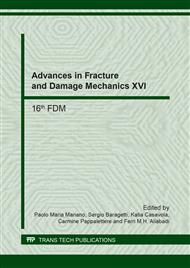[1]
X. Zhao et al: Active health monitoring of an aircraft wing with embedded piezoelectric sensor/actuator network: I. Defect detection, localization and growth monitoring. Smart Materials and Structures (2007). 16: 1208-1217.
DOI: 10.1088/0964-1726/16/4/032
Google Scholar
[2]
Y. Lu and J.E. Michaels: A methodology for structural health monitoring with diffuse ultrasonic waves in the presence of temperature variations. Ultrasonics (2005), 43(9) 717-731.
DOI: 10.1016/j.ultras.2005.05.001
Google Scholar
[3]
Z. Sharif-Khodaei and M.H. Aliabadi, Assessment of delay-and-sum algorithms for damage detection in aluminium and composite plates. Smart materials and structures (2014) 23(7): p.075007.
DOI: 10.1088/0964-1726/23/7/075007
Google Scholar
[4]
G. Yan. A Bayesian approach for damage localization in plate-like structures using Lamb waves. Smart Materials and Structures (2013), 22: 035012.
DOI: 10.1088/0964-1726/22/3/035012
Google Scholar
[5]
E.B. Flynn and M.D. Todd: A Bayesian approach to optimal sensor placement for structural health monitoring with application to active sensing. Mechanical Systems and Signal Processing 24 (2010), pp.891-903.
DOI: 10.1016/j.ymssp.2009.09.003
Google Scholar
[6]
M. Thiene, Z. Sharif-Khodaei and Aliabadi M. H: Optimal sensor placement for maximum area coverage (MAC) for damage localization in composite structures. Smart Materials and Structures 25 (2016), 095037.
DOI: 10.1088/0964-1726/25/9/095037
Google Scholar
[7]
M.S. Salmanpour, Z. Sharif-Khodaei and M.H. Aliabadi: Transducer placement optimisation scheme for a delay and sum damage detection algorithm. Structural Control and Health Monitoring (2016).
DOI: 10.1002/stc.1898
Google Scholar
[8]
B. Lee and W. Staszewski. Sensor location studies for damamge detection with Lamb waves. Smart Materials and Structures (2007), 16-399.
DOI: 10.1088/0964-1726/16/2/019
Google Scholar
[9]
M.S. Salmanpour, Z. Sharif-Khodaei and M.H. Aliabadi. Guided wave temperature correction methods in structural health monitoring. Journal of Intelligent Material Systems and Structures (2016) 1-15.
DOI: 10.1177/1045389x16651155
Google Scholar
[10]
M. Gresil and V. Giurgiutiu: Prediction of attenuated guided waves propagation in carbon fiber composites using Rayleigh damping model. Journal of Intelligent Material Systems and Structures (2014) Vol. 26 (16), pp.2151-2169.
DOI: 10.1177/1045389x14549870
Google Scholar
[11]
Tanaka. H, Sharif Khodaei. Z, Reliability Assessment of SHM Methodologies for Damage Detection. Key Engineering Materials (2016), Vol. 713, pp.244-247, (2016).
DOI: 10.4028/www.scientific.net/kem.713.244
Google Scholar
[12]
Michaels, J.E., Detection, localization and characterization of damage in plates with an in situ array of spatially distributed ultrasonic sensors. Smart Materials and Structures (2008) 17(3): 035035.
DOI: 10.1088/0964-1726/17/3/035035
Google Scholar
[13]
Ambrozinski L et al, Temperature compensation based on Hilbert transform and instantaneous phase for Lamb waves-based SHM systems of aircraft structures, Proceedings of the 9th Inter-national Workshop on Structural Health Monitoring (2013).
Google Scholar


